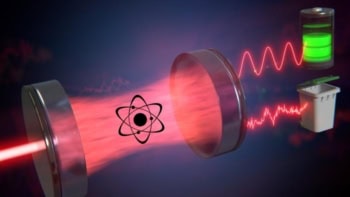
Researchers in Germany have performed a quantum gate operation between two quantum bits (qubits) in different laboratories. This marks a step towards distributed quantum logic, whereby system designers could build modular quantum computers, spreading qubits between different devices while allowing them to behave as one computer. Distributed systems would avoid crosstalk between qubits, which degrades quantum computations.
Adding qubits to a quantum computer is far trickier than adding bits to a classical one, as each qubit (which may be a trapped ion, a superconducting circuit, a diamond nitrogen–vacancy centre or many other physical manifestations of a quantum state) must be able to undergo the necessary logical interactions while also being protected from noise – which can destroy quantum information.
A significant noise source is interference between multiple qubits: “Let’s say there are three or four qubits in one device and you want to do a gate between just two of them,” explains Severin Daiss of the Max Planck Institute of Quantum Optics in Garching; “As they are all in one device you can still have crosstalk of those two qubits with the other qubits that should not participate in the calculation.” The more qubits are added to a single device, the more severe the crosstalk problem becomes. Other factors that cause problems in specific platforms are the difficulty of addressing specific qubits in large registers, restricted space, and problems with heat removal from large cryogenic samples.
Multiple devices
One possible way to scale up a quantum computer without scaling up the attendant problems would be to spread the qubits between multiple devices. However, this would require integrating the quantum logical operations performed on each device: “If you just calculate one result with one module and send the state to another module, you’re still not increasing the computational space that you have,” explains Daiss. “Quantum gate teleportation” – the construction of quantum gates whose output is conditional on the state of an input gate elsewhere – has therefore become an active field of research. Such gates have been demonstrated between ions in the same trap and superconducting circuits in a single cryostat, and one with photonic qubits, albeit with a tiny success rate.
In the new research, Daiss and colleagues led by Gerhard Rempe unveil a radically different, conceptually-simpler gate that is based on the interaction of a single photon with modules in two different laboratories. In each laboratory, they set up an optical cavity containing a single rubidium atom and they link the two systems using a 60::m optical fibre. To implement the gate, they send a photon as a “flying qubit” along the fibre and reflect it successively from the two cavities, thereby entangling its polarization with the rubidium energy levels. A measurement of the photon is then combined with a conditional feedback on the qubit to realize a CNOT gate – one of the key components of quantum logic.
Heralded quantum gate
The protocol produces a “heralded” quantum gate in which the detection of the photon signals a successful gate operation. In future, this could prove crucial to producing a reliable quantum computer as such a confirmation that each successive gate has worked is important if multiple gates are connected in sequence. Other platforms could theoretically produce quantum gates using the researchers’ protocol, says Daiss, if the qubit could be coupled sufficiently strongly to a cavity or resonator. For instance, this has already been achieved with trapped ions or superconducting qubits.

‘Lattice surgery’ entangles fault-tolerant topological qubits
In future, says Daiss, a next step would be to connect together modules comprising more than one qubit and producing computers with more than one module: “We could go in either direction, and both directions will benefit from the work we’re doing at the moment,” he concludes.
Ronald Hanson of Delft University of Technology in the Netherlands believes the paper marks an important step forward: “They just have this one photon scattering off one side, going to the other side and then you measure it. Conceptually it’s super simple, and they show that it works.” he says. “So it’s the fact that it’s heralded, and its efficiency – I think that’s the real novelty of the work.”
The research is described in Science.



